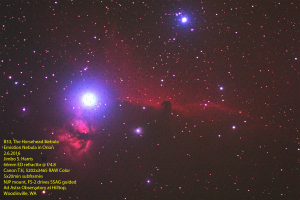There are quite a few planets coming around for a pass; Jupiter is up pretty early in the evening these days, and by morning, Jupiter, Mars, and Saturn are arrayed across the sky. Venus and Mercury are also up before dawn, but they are very close to the Sun, and so I’m not messing with those.
Anyway, Pumpkin is great for big nebulae, and I look forward to cruising the Summer Milky Way with her in a few months. But Spring is for galaxies, and they are tiny.
Between galaxies and planets, I knew it was time for a change, so, just like you’re not supposed to, I stopped everything in the middle of the night, and swapped telescopes. I would have put Trixie up, which is a much easier focal length to handle, but I can’t lift Trixie to the observing deck by myself, and I didn’t think that my wife would appreciate being asked to help heave her around in the dark, so I went with the much more portable SCT, Cassie (which, as you’ll recall, is a 9.25″ f/10 scope, focal length 2350mm).
I was a little worried about focusing (always a nightmare), but Cassie comes equipped with a manual focuser (so it’s easy for me to do), and a Bahtinov mask, and with the T3i’s flip out screen, I was focused in seconds!
Balance, add a counterweight, … what with one thing and another, it didn’t take long to get set up.
The new focal length (2350mm vs. 320mm on Pumpkin) makes everything a bit more challenging; guiding, target selection, the whole bit.
Of course, this coincided with the autoguider deciding to go a little weird, too — suddenly, I can’t guide within 2″, where Cassie needs 0.5″ or better (which is a lot to ask of any sky, let alone under the Jet Stream), while it had been doing within 1″ easily, where Pumpkin only required 2.5″. grumble. I’ll get it figured out. Honestly, the real answer is “stop guiding, and just surf on the seeing”.
Anyway, I shot some B33 with Pumpkin before the switch, and some M81 with Cassie afterwards. Here’s the Horsehead (rotated so that North is left):

It turns out that M81 failed to resolve enough for a postable shot, even with a stack of six 20m images; shooting at f/10 is serious. By the time I finished with M81 and was trying to center up M65/M66, the clouds started to roll in, and I decided to call it a night.
I have a photo-processing backlog at the moment, but hopefully I will get around to stacking up a few images soon.

MOST COMMENTED
Observatory
Observatory 2.0 – Time has come today!
General / Maintenance
First Light, a deeper look
Mount / Observatory / Telescope
Observatory 2.0 – Result!
Observatory
Observatory 2.0 – The Pier goes in
Gear / General / Maintenance
Martin Farmer Wormblock installation notes
Deep Sky / Long Exposure Photography
NGC2244, The Rosette Nebula
Deep Sky / Long Exposure Photography
Another beautiful night.